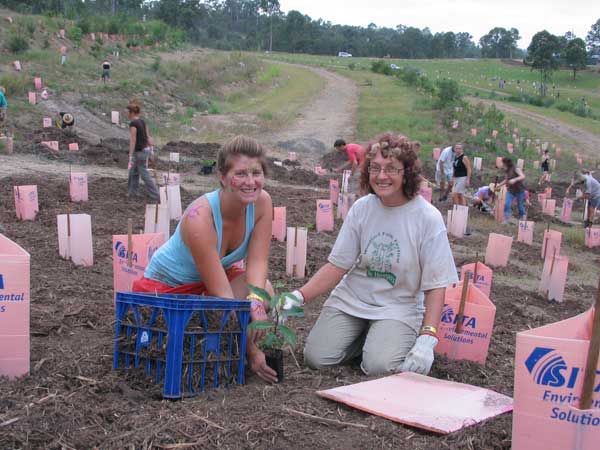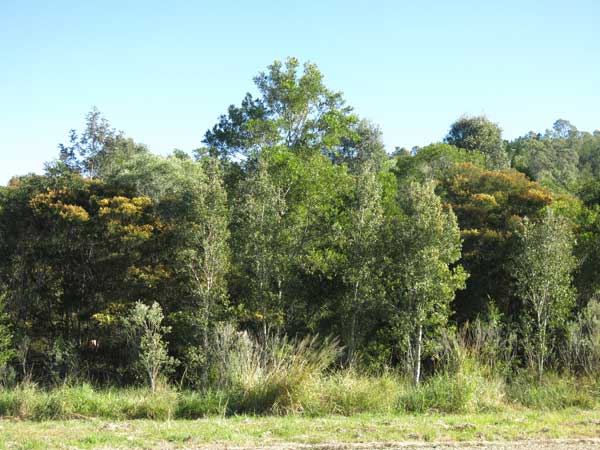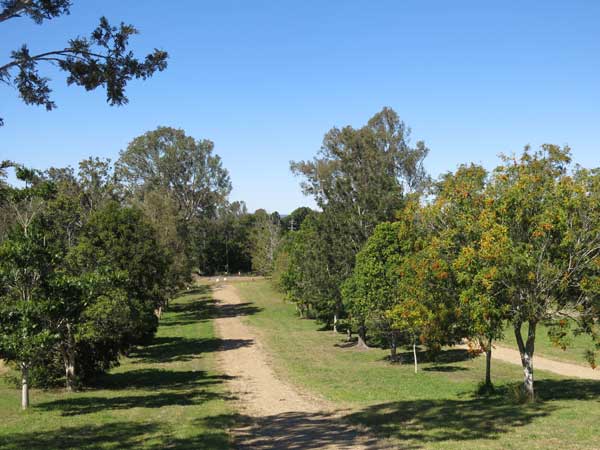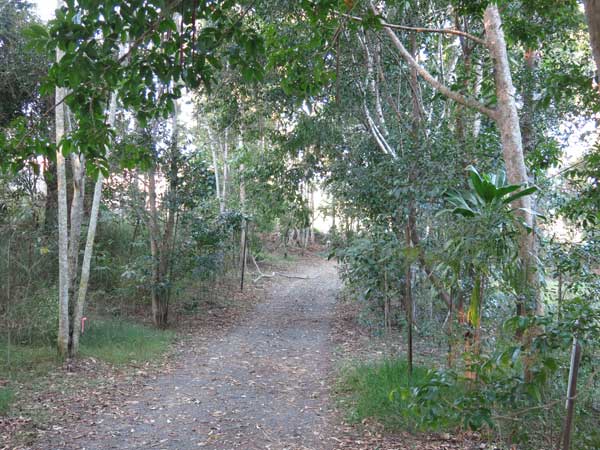At first glance the two concepts – staging a major cultural festival and managing a property for wildlife – seem incompatible. Yet organisers of the Woodford Folk Festival have made great progress with both. Their annual event is now internationally renowned and the venue is becoming a haven for wildlife.
It began in 1994 when, after the Maleny Festival grew so that it was bursting at the seams, the non-profit Queensland Folk Federation Inc (now Woodfordia Inc) purchased a 500 acre block of land near Woodford. The property, now named Woodfordia, became registered as a Land for Wildlife property in 2007.
It was a dairy cattle property nestled up against what is now the Bellthorpe National Park in the southern Conondale Range. The Jinibara are the registered Native Title holders in this area.
Organisers realised that here was an opportunity to do more than stage a music festival. Along with ownership of a block this size, there was a responsibility to leave a legacy for future generations by rehabilitating the site, and with this came the prospect of developing a cultural and environmental showcase.
Festival infrastructure was an urgent priority but so was revegetation, needed to increase comfort levels for festival patrons, provide campers with shade, minimise dust, create wildlife corridors, improve soil quality and prevent erosion.
It all looked a bit daunting at first. Weeds were rampant, paddocks had nothing but introduced grasses and different soil types – rocky, shale or heavy clay – indicated a few difficulties ahead; acidic soil as well, the result of an old pine plantation.
On the plus side, there were vegetated gullies, some bushland with areas of dry eucalyptus and rainforest, and a reasonable riparian zone along the watercourse which flows to the Stanley River.
The biggest plus though was an enthusiasm and determination to begin the process of ecosystem restoration. So was born the annual Tree Planting Weekend, first held in 1997. Now known as The Planting, it began with the primary aim of getting as many trees into the ground as possible. Festival patrons of all ages came to help, putting in thousands of trees (current total: 106,000) and after 20 years the transformation of the site from paddock to parkland is very evident.
A huge range of species was planted, mostly endemic rainforest trees being favoured. Organisers set up teams for particular areas, each team having a leader who demonstrated the basics – dig hole, add a little nutrient, place tree, heap up soil, position tree guard, water well, mulch well. The trees were then left to themselves, with some spectacular results and some disappointments. Survival rate is about 60%.
Crucial to a good outcome was to choose species appropriate to the soil, terrain, and intended usage, such as meeting festival needs or creating wildlife habitat. There was much success with Hoop, Bunya and Kauri Pines, whereas Wollemi Pines perished. Site preparation, mulching for example, well before planting, showed better results, as did replacing straw bales with hardwood mulch. Pink tree guards were used, this colour best concentrating photosynthetic energy to help plants grow.
Most crucial of all was support from patrons and volunteers who came along to The Plantings to be involved, often working in the rain, and often coming back year after year. Highly successful was a Bunya Baby project. Bunya Pines in tubes were given to patrons to take home, nurture for a few years, and then return to be planted out on Araucaria Hill, which overlooks the Festival precinct and already had Hoop Pines in abundance.
The Planting Festival inspired a group of volunteers to form Treehuggers, who meet each month to carry on with yet more planting and maintenance.
This in turn led to the creation of various environmental projects – Forest Woodfordia, Bush Foods, Orchids, Native Grasses and Butterfly Host plants. Then there is a project growing plants to use on Festival stages, others concentrating on Cycads and Tree Ferns, and Weedfordia, which has the challenge of dealing with the ubiquitous weeds. All this allows attendees to work at their own particular passion when Treehuggers meet or when The Planting is staged.
Butterflies are a special attraction. The Butterfly project has planted food species for rare butterflies – Richmond Birdwing, Laced Fritillary and Regent Skipper. Conservation of all invertebrates, not just butterflies, is the overall aim.
The Planting itself has shifted focus from mass tree planting to an event with a stronger educational component, workshops and discrete environmental projects. Even so, this year patrons planted 785 trees, 159 butterfly host plants, and, following a successful trial, 300 native grasses.
These days there’s more science behind the revegetation. Soil health is critically important, and fungi have a starring role. Woodfordia has a trained fungal researcher in its environmental team, and the aim is to utilise fungi to increase plant growth. By inoculating mulch and other organic material with fungi, more water is retained, plants flourish, weeds are suppressed and erosion is lessened. Fungi habitat is also useful for earthworms, wood lice, termites and larger animals and so on up the food chain. It’s a simple and low-cost technique which holds much promise.
Another innovative measure at Woodfordia is the use of biochar, which enhances soil and sequesters carbon. Bamboo has been planted on site for use in construction but it requires preservation in a bamboo smoker, the biochar being a by-product of this process. Other soil nutrients come from a giant compost heap formed from organic waste generated by the festival. An inventive waste water treatment plant has been installed.
Wildlife on the property appears to be thriving. Several dams and ponds form habitat for amphibians. Many bird species have been recorded, 217 at least, most either resident or regular visitors. The vulnerable Glossy Black Cockatoo may be seen. The number of species has remained fairly constant, but there has been an expected decline in overall numbers of grassland habitat species, with a corresponding increase in woodland habitat species.
Red-necked or Bennett’s Wallabies are common. And many reptiles – goannas, water dragons, bearded dragons, brown snakes, common and brown tree snakes, carpet pythons and Red-bellied Black Snakes. Birds, Sugar Gliders and three species of possum take advantage of more than 400 installed nest boxes.
Feral animals with their destructive habits intrude. Red Deer, Rusa Deer and wild pigs, which enter from the adjoining National Park, foxes and cats all pay unwelcome visits. Management strategies are in place but, as with weeds, it’s a perennial problem.
Much has been achieved at Woodfordia, but much more remains to be done. If you’d like to become involved, come along to The Planting in 2018, or join Treehuggers on the last weekend of every month. You’ll need to register – email [email protected] or phone Woodfordia’s office – 5496 1066.




Article by John Burrows
Land for Wildlife member
Cooroy, Noosa and Woodfordia Inc. member
